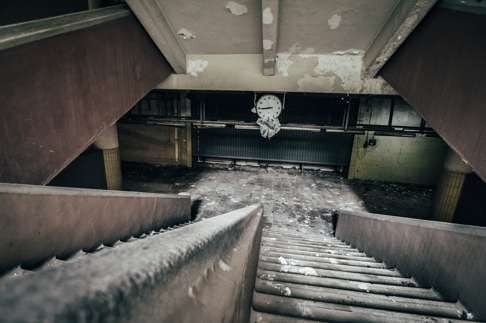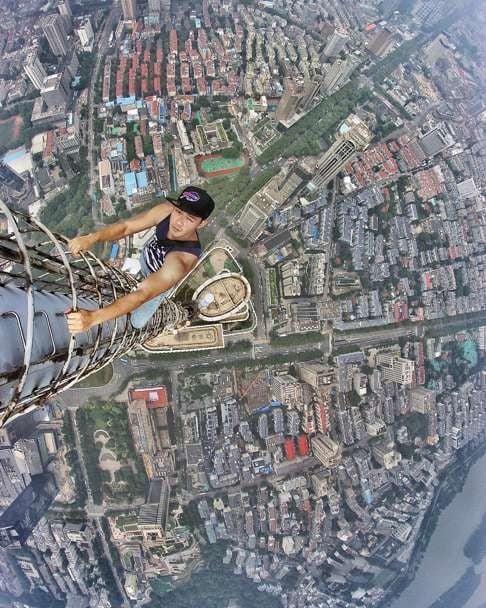
The Hong Kong urban adventurers for whom nothing is too tall, or deep, or spooky
Daredevils explore the city from all angles - most of them illegal - taking selfies atop skyscrapers or videoing their tours of an abandoned mine, a sunken ship, a derelict cinema, or a murder site
Clambering to the top of Hong Kong’s skyscrapers, Dex Ng is often blown away by the sense of tranquillity from high above the city’s noisy and crowded streets.
“The only sound I hear up there is the wind. But looking down, you can see scores of people and cars streaming by. The contrast couldn’t be greater,” says Ng, a director at a video production company.
He is a member of a group called Exthetics – an amalgam of “extreme” and “aesthetics” – daredevil photographers who climb to the top of towering skyscrapers to snap vertigo-inducing shots of themselves and the surroundings.
Ng set up Exthetics in 2014 with two friends, Daniel Lau and Lawrence Tsui, and a video clip they posted of Lau and other members snacking on bananas while hanging from the lightning rod of The Center, a 73-storey tower in Central, quickly went viral.
Lau, a 24-year-old university student, says their idea is to explore a side of Hong Kong that is rarely seen.
“People go to The Peak to see the night view and visit Tai Tam Country Park to see the red leaves. These are all well-trodden places. We want to explore nooks and crannies that are off the beaten track, like abandoned factories and construction sites. We want to push the boundaries when taking pictures, so people can see that they don’t have to look at Victoria Harbour only from eye level,” Lau says.
Some Hongkongers complain of limited recreational options and a lack of scenic spots in the city. But the emergence of urban exploration groups such as Urban Fragment (made up mostly of photography buffs who enjoy checking out deserted sites) show otherwise.

HK Urbex was set up in 2013 and has since amassed a huge repository of video, photographic and written records of their visits to abandoned or forbidden sites.
Because their expeditions often involve trespass, the group’s seven members adopt pseudonyms to keep their identities hidden. The Urbex team also does not reveal the locations and how they are accessed to avoid the sites being swamped by visitors – common practice among urban explorers worldwide.
Ghost, a British writer who has lived in Hong Kong since he was a child, is the chief writer and researcher for HK Urbex.
Describing their destinations as “non-places”, he says they are “places that normal people couldn’t go to every day or some infrastructure projects that the public can’t get access to”. A cavernous site carved underground for the MTR South Island line is one example.
Instead of warning them off, “No Entry” signs act like beacons for urban explorers like Ghost and his friends
“Though we trespass, we’ve never run into trouble with police, luckily,” he says. “We are quite professional. We go to a site several times for scouting to see how we can get in without breaking stuff. We find access points and observe the security situation before going inside.”
He identifies potential exploration sites from news reports about heritage sites and urban redevelopment plans. Forums for war games players and graffiti artists are another source of ideas.
So when a Vietnamese freighter called Sunrise Orient was reported to have run aground just off Cheung Chau island, the news soon attracted the Urbex adventurers.
Learning that the stricken ship was only 10 metres from shore, Ghost donned his swimming togs, grabbed a waterproof bag and swam out.
“We only took a GoPro [action camera] as we had to go in the water, and someone filmed from the top with a drone. It was an amazing experience but a bit dangerous. I wouldn’t ask anyone to do it.”

It’s like I am doing an adventure game. The video aspect is very fun. The abandoned mansion on The Peak we went to is like one of the mansions in Resident Evil
For Australian-born writer Jenkins, who built the Urbex website, their expeditions are not unlike venturing into life-size settings of video games.
“It’s like recreation for me. It’s like I am doing an adventure game. The video aspect is very fun. The abandoned mansion on The Peak we went to is like one of the mansions in Resident Evil [a popular horror video game],” he says.
“The Ma On Shan mine was really cool, too. It took us 90 minutes to go there. We went down two levels. It turned out there were still seven levels below. It’s very deep – when you go to a certain point in the mountain, all communications get cut. We didn’t go all the way down as it’s dangerous.”
As a history buff, fellow Urbexer Pripyat rates the derelict Hoi Hing Building in Tai Kok Tsui as his favourite destination. The old residential building gained notoriety after a young tenant in one of the 270 units murdered his parents there in 2013 and kept their dismembered remains in refrigerators.

Where many people see only squalor and grime, Pripyat, a videographer, sees a trove of stories. Stepping past piles of rubbish, he picks up family albums that offer glimpses of the lives of former inhabitants; in another unit, the way personal belongings are strewn around suggest that the tenants moved out in a hurry.
When you enter somebody’s home, you can learn a lot about that moment in time
“When you enter somebody’s home, you can learn a lot about that moment in time,” he says.
Their visit to Green Island, which held a reception centre for Vietnamese refugees, was the most personal to him.
“My mother-in-law stayed in such a camp for seven years. She is from north Vietnam and came to Hong Kong by boat. To be able to visit a place that is a part of my family history is the kind of experience you can’t get in a museum,” Pripyat says.
“I was blown away by how small the camp was. There were no recreational facilities. I heard [her talk about it] before, but I’d never experienced it.
“The old camps are well preserved. There are still documents, including one[about] a guard who was being reviewed after two people escaped ... I can look into that moment in history and see someone else’s life.”
Lots of old buildings are disappearing very quickly and no one is documenting them.
Yet for all their interest in local history, none of Urbex’s members are Hong Kong-born and -raised.
Although some locals are engaged in urban exploration, Ghost claims their work does not show much creativity. “They just put up a picture of an abandoned bus or a photo of a run-down room, and that’s it. They don’t tell the stories. There’s no editing, no thinking about the angle, no words giving any context,” he says.

Ghost reckons most new developments lack soul ,whereas old buildings often have a beauty of their own, which is why Urbex crew plan to release a coffee table book featuring highlights from their adventures later this year.
As for Exthetics, the celebrity their death-defying stunts brings has led to the commercialisation of their hobby. Their Instagram account – featuring photos of members walking on the edges of rooftops and sitting on ledges at dizzying heights – has since attracted nearly 100,000 followers. This, in turn, has brought sponsorship from companies such as Adidas.

Each venture requires careful reconnoitring to bypass security. And although Hong Kong probably has more skyscrapers than any other city in the world, Lau says the group has already been looking farther afield for rooftops to conquer.

Similarly, the Exthetics crew have turned rooftops in the region into their playground. Lau says he reached the top of a 118-storey building in Shenzhen last year, and also conquered similar structures in Taipei, Jakarta, and other Chinese cities. He’s going to look for more.
“We have done it in Hong Kong for two years and I have been to over 100 buildings already,” says Lau. “There are only that many that you can do.”

